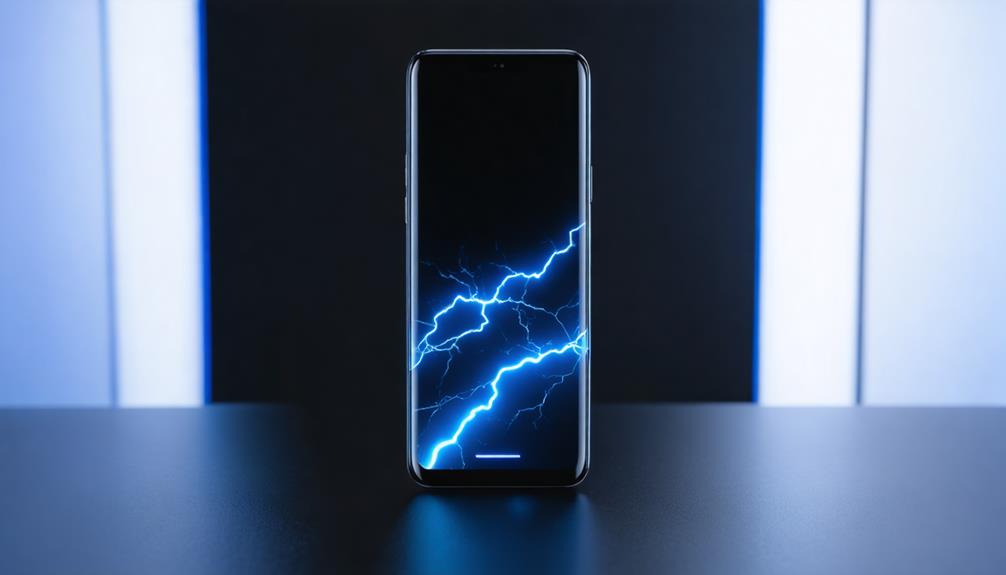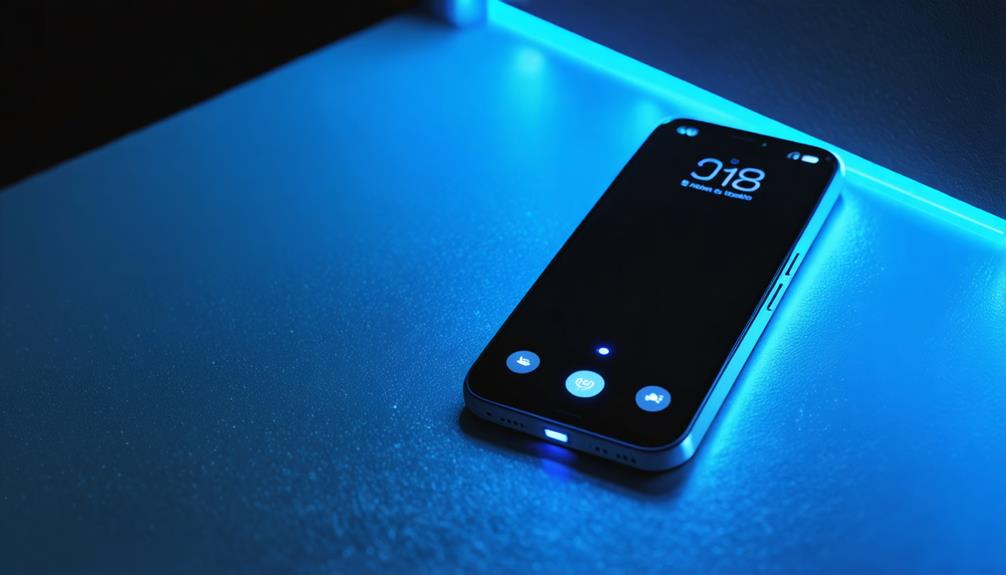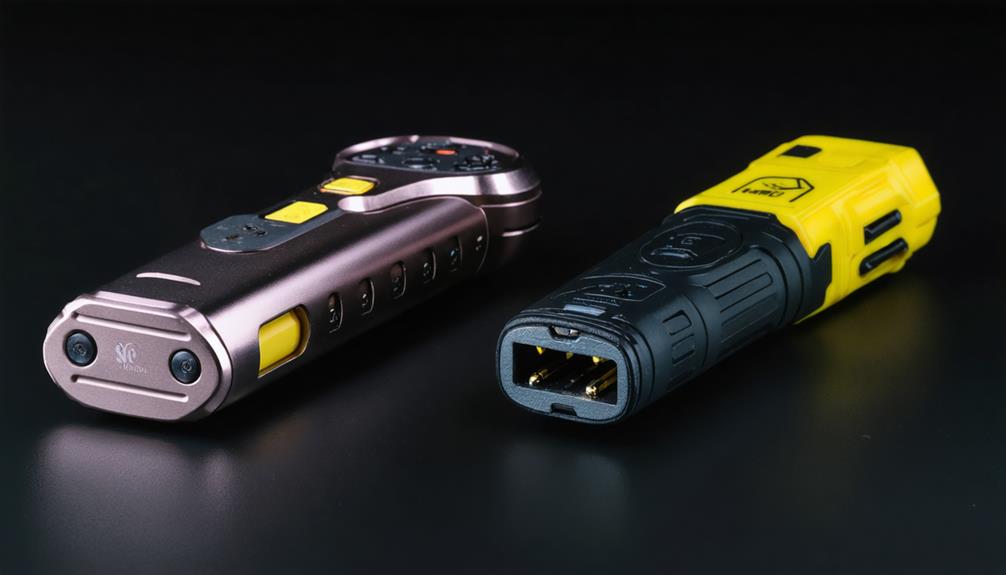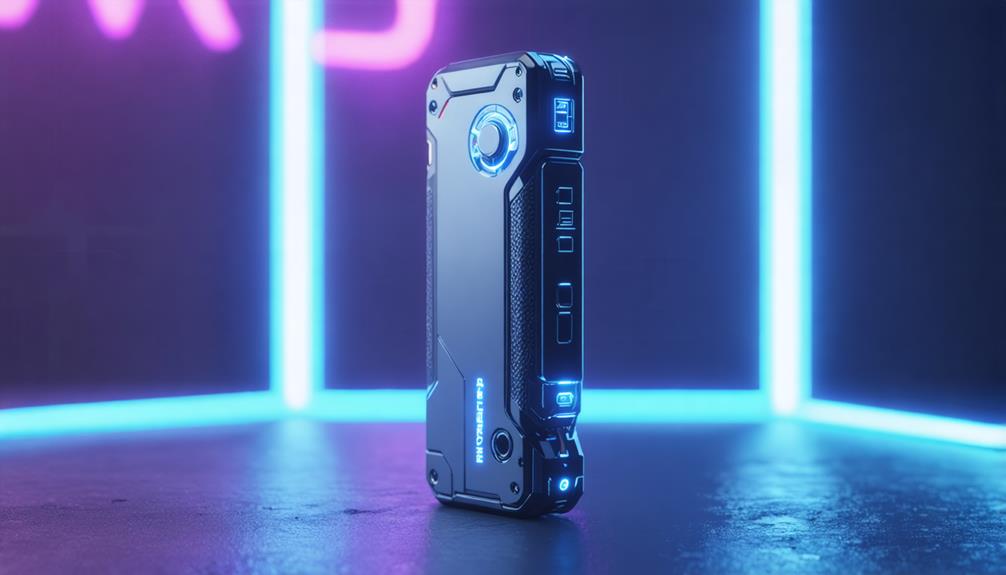
Brainstorm Security Shop

For Orders Over $99

On Any Of Our Products

Details On Refund Page

In the evolving landscape of personal security, the Phone Taser emerges as a groundbreaking innovation, merging the ubiquitous smartphone design with a potent self-defense tool. This device, discreet in appearance yet formidable in function, challenges traditional notions of safety equipment. As we explore the intricacies of its design, the balance between accessibility and power becomes a focal point, raising questions about its practicality and the implications for everyday carry. What does this mean for the future of personal protection, and how might it reshape our approach to safety in an increasingly unpredictable world?
The Phone Taser, a recent innovation in personal safety technology, integrates the functionality of a stun gun into a device that resembles a smartphone. This dual-purpose mechanism offers individuals a discreet and convenient means of self-defense without the overt appearance of traditional self-defense tools.
By embedding taser functionality into a device mimicking a familiar object, users are provided with both a sense of security and an element of surprise against potential threats.
User experiences with the Phone Taser highlight its effectiveness and practicality. Many users report feeling empowered by the ability to carry a protective tool that fits seamlessly into their daily routine and environment.
Furthermore, the ease of use is frequently praised, as the device’s intuitive design allows for quick activation in urgent situations. The incorporation of taser technology into a smartphone-like design also facilitates wider acceptance and usage among those who might otherwise be hesitant to carry a conventional stun gun.
Crafted with precision, the Phone Taser exemplifies a seamless blend of innovation and practicality, boasting key features that enhance its functionality and appeal. The design aesthetics of the Phone Taser are meticulously crafted to ensure it maintains a sleek and modern appearance. Its compact form factor allows for discreet carrying, while its robust materials ensure durability without sacrificing elegance. The ergonomic design provides a comfortable grip, ensuring ease of use when needed.
The user interface of the Phone Taser is intuitive, designed to facilitate quick and efficient operation. A simple touch interface allows users to activate the device swiftly, minimizing response time in critical situations. The interface is complemented by a clear, easy-to-read display that provides essential information such as battery life and operational status.
| Feature | Description | Benefit |
|---|---|---|
| Design Aesthetics | Modern and sleek | Discreet and stylish use |
| User Interface | Intuitive touch controls | Rapid activation |
| Ergonomic Design | Comfortable grip | Enhanced usability |
Additionally, the Phone Taser integrates seamlessly with various mobile devices, enabling users to access its features through dedicated applications. This integration enhances its utility by providing remote control options and further customization, all within a user-friendly platform.

Integrating cutting-edge design with advanced technology, the Phone Taser not only stands out in aesthetics but also significantly bolsters personal security. As modern threats to personal safety evolve, so too must our self defense strategies.
The Phone Taser offers a discreet yet powerful tool for individuals seeking to enhance their personal safety without drawing unnecessary attention. Its design ensures ease of access, making it a reliable option during emergencies.
The compact nature of the Phone Taser allows it to be seamlessly integrated into everyday life, providing an element of surprise against potential threats. This device empowers users with a sense of confidence, knowing they possess an effective self defense mechanism that can be deployed swiftly.
Moreover, the actuation of the taser is designed to be intuitive, minimizing the chances of user error in high-stress situations. Additionally, the Phone Taser is equipped with features that not only incapacitate aggressors but also ensure the user’s safety during its operation.
This thoughtful integration reflects a comprehensive approach to self defense strategies, prioritizing both the effectiveness and safety of the user. By offering an innovative and practical solution, the Phone Taser redefines personal safety in today’s dynamic environment.
At the heart of the Phone Taser lies a sophisticated blend of electronics and engineering, enabling its dual functionality as both a communication device and a self-defense tool. This innovative device seamlessly integrates advanced battery technology, ensuring it can sustain both its phone and taser operations without compromising performance in either capacity. The battery is designed for high efficiency and quick recharge, allowing users to rely on the device in critical situations.
The user interface of the Phone Taser is crafted with precision, focusing on ease of use to ensure quick accessibility during emergencies. The interface is intuitive, allowing users to switch between phone functions and taser activation swiftly. The device employs a multi-layered security system to prevent accidental discharge, incorporating fingerprint recognition and a dedicated safety switch.
Packed within its sleek design are microprocessors that manage the device’s power distribution, optimizing both communication and defense functionalities. The integration of high-quality materials ensures the Phone Taser remains lightweight yet durable, capable of withstanding daily use and emergency scenarios alike.
This convergence of cutting-edge technology and user-centric design positions the Phone Taser as a pioneering tool in personal safety and communication.

In comparing phone tasers to traditional tasers, key considerations include size and portability, power and effectiveness, as well as safety and regulations.
Phone tasers offer enhanced portability due to their compact design, making them more convenient for everyday carry compared to bulkier traditional models.
However, assessments of power and effectiveness, along with adherence to safety and regulatory standards, are crucial in evaluating their practical application and legal compliance.
Compactness and convenience are key considerations when comparing phone tasers to their traditional counterparts. In today’s fast-paced world, individuals seek self-defense tools that are not only effective but also easy to carry and discreet. Phone tasers offer a significant advantage in this regard due to their compact design. Unlike traditional tasers, which can be bulky and cumbersome, phone tasers are designed to mimic the size and shape of a mobile phone, allowing them to fit seamlessly into a pocket or bag. This streamlined form factor ensures that users can carry these devices without attracting unwanted attention.
In addition to their compact design, phone tasers are constructed using lightweight materials, further enhancing their portability. Traditional tasers often use heavier components, which can make prolonged carry uncomfortable. In contrast, the use of advanced materials in phone tasers reduces their overall weight, making them easier to handle and transport.
This lightweight aspect is particularly beneficial for individuals who require a self-defense tool that can be carried effortlessly throughout the day. Overall, the size and portability of phone tasers present a compelling alternative to traditional models, catering to modern demands for practicality and discretion in personal safety devices.
While the compact design and portability of phone tasers address the need for discreet self-defense tools, their power and effectiveness are equally critical considerations. Phone tasers, by virtue of their design, must balance between maintaining a practical size and delivering sufficient electric discharge to deter assailants. Traditional tasers, often bulkier, have the advantage of accommodating more robust taser technology, which can result in a more powerful shock and longer range. Thus, when evaluating these devices for personal defense, understanding these differences is crucial.
| Feature | Phone Taser | Traditional Taser |
|---|---|---|
| Size | Compact | Larger |
| Voltage Output | Lower | Higher |
| Range | Close contact | Up to 15 feet |
| Rechargeability | Often rechargeable | Usually rechargeable or replaceable |
| Discreteness | High, due to phone-like appearance | Low, visibly a weapon |
The effectiveness of a phone taser largely depends on its capacity to deliver a sufficient electrical charge to incapacitate an attacker momentarily. Although less potent than traditional models, phone tasers can still serve as an effective personal defense tool in close-contact situations. The choice between a phone taser and a traditional one ultimately hinges on the user’s preferences and specific defense requirements, balancing power with ease of use and portability. The integration of advanced taser technology in phone tasers continues to evolve, pushing the boundaries of what these compact devices can achieve.
Navigating the safety and regulatory landscape of self-defense tools like phone tasers and traditional models is crucial for both manufacturers and users. In the realm of self-defense strategies, ensuring that devices meet rigorous safety standards is essential to guarantee personal security without unintended harm.
Traditional tasers have long been subject to stringent regulations, requiring compliance with safety protocols to prevent misuse and excessive force. These regulations often include limitations on voltage, accessibility to civilians, and mandatory training for proper usage.
Phone tasers, as a novel adaptation, present a unique regulatory challenge. Their discreet design offers a strategic advantage in self-defense strategies. However, this very discreetness can raise concerns about accidental deployment or misuse.
Regulatory bodies are increasingly focusing on ensuring that phone tasers incorporate safety features, such as trigger locks and clear usage guidelines, to mitigate risks.
Comparatively, the regulatory landscape for traditional tasers is more established, offering a clearer framework for manufacturers and users. As phone tasers gain popularity, aligning their production with established safety standards of traditional models is imperative.
This alignment not only enhances personal security but also fosters consumer trust in new self-defense technologies.
The introduction of phone tasers necessitates a thorough examination of compliance with local laws, as regulations governing self-defense tools vary significantly across jurisdictions.
It is crucial to establish ethical use guidelines to ensure these devices are operated responsibly, balancing personal safety with public welfare.
Stakeholders must engage in ongoing dialogue to address potential legal ramifications and ethical dilemmas associated with widespread adoption.
Understanding and adhering to local laws is paramount when considering the use and distribution of phone tasers. These devices, which combine traditional self-defense mechanisms with modern technology, must comply with local legislation to ensure both legal use and consumer safety. Different jurisdictions impose varying regulations regarding stun devices; therefore, manufacturers and distributors must be well-versed in these laws to avoid legal repercussions.
Local legislation often dictates the specifications and operational criteria that phone tasers must meet. For instance, some regions may have stringent requirements on the voltage output, ensuring that the device is effective yet non-lethal. Moreover, safety standards play a critical role in the design and functionality of these devices. Adhering to established safety standards, such as those outlined by recognized bodies, not only enhances user safety but also fosters consumer trust and product reliability.
In addition, distributors are often required to provide clear instructions and warnings with these devices to comply with regulatory standards. This includes informing consumers about the legalities surrounding their use and potential liabilities.
Understanding these legal frameworks is essential to navigate the complexities of compliance, ensuring both the legal operation and ethical dissemination of phone tasers in the market.
Balancing legal frameworks with ethical considerations is vital in the deployment and use of phone tasers. As these devices gain traction for personal defense, it is crucial to address the ethical implications surrounding their use. Ensuring that phone tasers are employed responsibly requires a comprehensive understanding of both legal mandates and moral responsibilities.
Ethical guidelines should emphasize the principle of responsible ownership, encouraging users to understand the potential consequences of misuse. The ethical implications of phone tasers extend beyond individual safety to broader societal impacts. Users must recognize the potential for harm, both physical and psychological, that these devices can inflict.
It is essential to promote awareness about the appropriate contexts for their use, ensuring they serve as a means of self-defense rather than aggression. Moreover, manufacturers and distributors have an ethical obligation to provide clear guidelines and training resources, fostering responsible ownership.
This includes educating users about the legal and ethical ramifications associated with phone tasers, as well as offering support for safe usage practices. By prioritizing ethical use guidelines, stakeholders can help mitigate risks and promote the responsible integration of phone tasers into personal security strategies.

As technology continues to evolve, personal security devices are rapidly transforming into sophisticated tools designed to ensure user safety in a variety of environments. The integration of technology such as AI and IoT into self defense strategies presents promising future innovations. Devices like the phone taser exemplify how traditional safety tools can be reimagined to offer enhanced protection while maintaining user convenience.
Looking ahead, future personal security devices are likely to incorporate advanced biometric systems, enabling seamless identification and user-specific responses. For instance, a device could analyze a user’s stress levels or physical condition to automatically trigger an alarm or alert authorities.
Additionally, the use of real-time data analytics could enable these devices to predict potential threats based on environmental factors, providing preemptive defenses and alerts.
Moreover, the miniaturization of technology will likely lead to more discreet and portable security solutions. Wearable devices, such as smartwatches with integrated defense mechanisms, are expected to gain popularity.
As these technologies advance, their accessibility and affordability will be crucial to ensuring wide adoption, ultimately enhancing personal security for individuals across diverse demographics and geographies.
The battery life of electronic devices is contingent upon usage patterns and battery maintenance. Adhering to proper safety precautions and regular charging can optimize performance, ensuring reliability and longevity for devices requiring frequent power availability.
The use of electronic devices in wet conditions raises safety concerns due to potential electrical hazards. Adhering to usage guidelines is crucial to prevent accidents, ensuring the device is used solely in dry and controlled environments.
Determining compatibility across various smartphone models requires consideration of both taser safety and smartphone technology standards. Compatibility may vary due to differing design specifications, necessitating thorough examination of each device’s technical capabilities and safety protocols.
The charging time of a device is contingent upon its battery capacity. Typically, larger battery capacities necessitate longer charging periods. Understanding the specific battery capacity can provide a more precise estimate of the device’s full charging duration.
The effective range of taser technology varies, typically spanning a few meters, depending on the model. Safety concerns may arise regarding distance and accuracy, necessitating proper training and adherence to guidelines to ensure safe and effective use.
The Phone Taser represents a significant advancement in personal security devices, merging discreet design with effective self-defense capabilities. Its integration of advanced technology and user-friendly features offers an innovative alternative to traditional tasers, enhancing personal safety while maintaining comfort and ease of use. Legal and ethical considerations continue to shape the development and deployment of such devices. As technology evolves, the Phone Taser exemplifies the potential future direction for personal security solutions, balancing efficacy with societal norms and regulations.
Brainstorm Security Shop
1867 Caravan Trail
Ste 105
Jacksonville, FL 32216
Call us toll free: (800) 859-5566